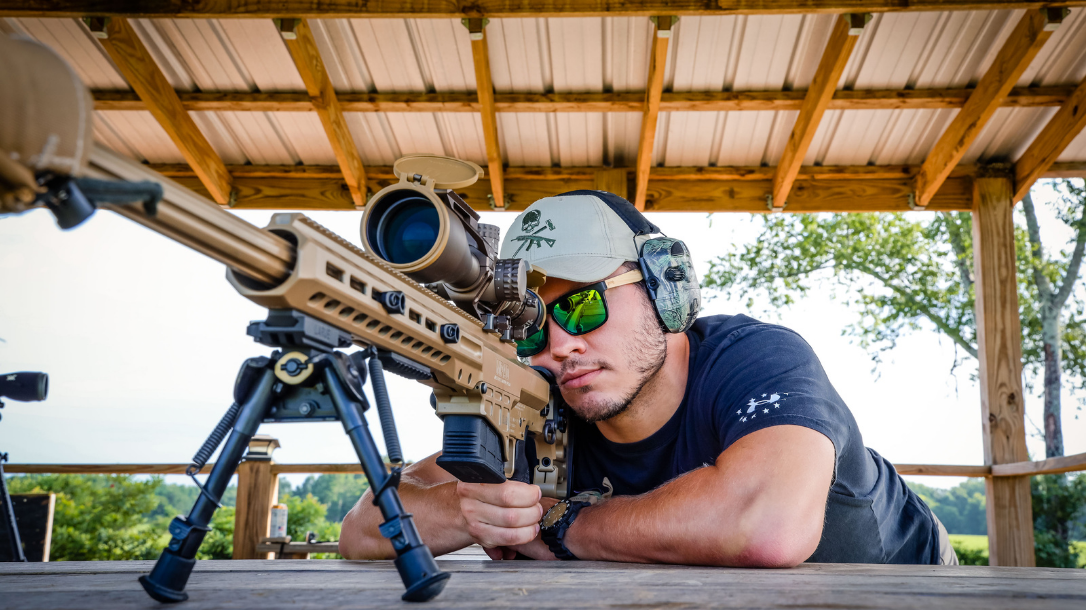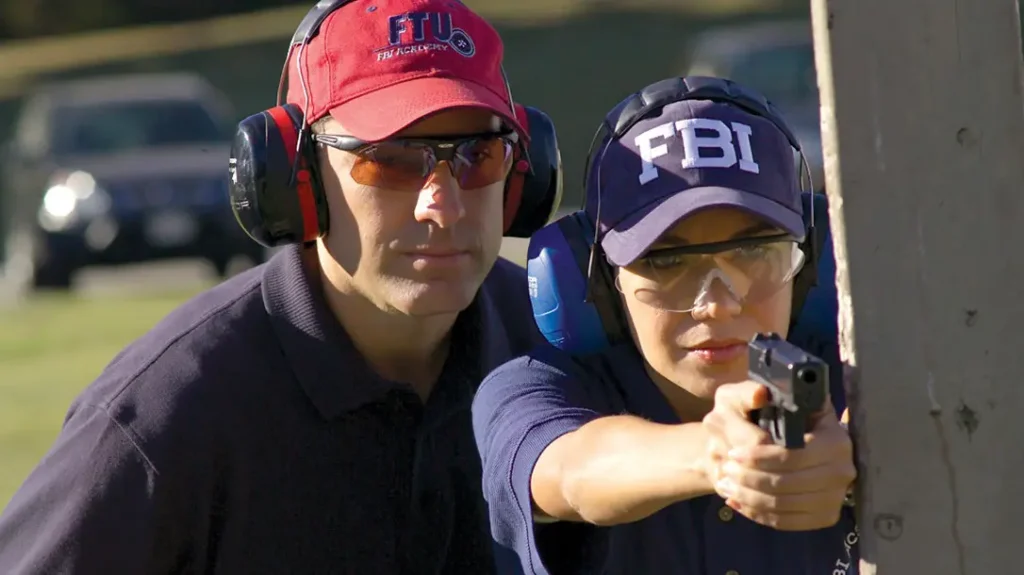The Barrett MRAD MK22 started its story back in 2016. SOCOM announced they wanted an Advanced Sniper Rifle. The guys who wrote the specs were clearly long-distance shooters with a lot of experience under their belts.
Barrett Wins the Contract Running Away
When the competition ended, Barrett was awarded the $50 million contract for a version of their MRAD (Multi-Role Adaptive Design) bolt-action repeater. Per the contract, the MK22 came with three barrels: 7.62x51mm, .300 Norma Magnum and .338 Norma Magnum. The .300 NM is for anti-personnel, the .338 NM is for defeating material/armor plating and the 7.62x51mm is simply for short range urban environments and practice with the gun while shooting rounds that don’t cost $10 each.
Speaking of ammunition, this gun wasn’t designed to be fed with a box of cartridges you picked up at Wally World on the way to the range. SOCOM also did a competitive bid for who would make the ammo for this gun. Berger won that contract, and a company that normally made bullets was now making very accurate, very effective ammunition. They use virgin Lapua cases, and the rest is a proprietary secret. I’m guessing there must be some magic pixie dust and unicorn horn in there to make it so accurate.
Advertisement — Continue Reading Below
Barrett MRAD MK22 Details

What features do you get on a sniper rifle when looking for perfection? First, you get a 7000-series aluminum chassis gun that is infinitely modular. The Barrett MRAD MK22 weighs more than 15 pounds without ammo, a scope or a suppressor. It is about a pound lighter when configured with the shorter 7.62x51mm barrel. This is not the rifle you want to take elk hunting in the Rockies unless you want to do a CrossFit workout while you hunt. The monolithic forend has a full-length (23 inches) Picatinny rail on top and M-LOK mounting slots on both sides and the bottom. The Picatinny rail has a 10 Mils built-in taper to aid in long-distance shooting. A scope won’t “top out” of come-ups as soon if it is already angled slightly down. The bolt is encased in a polymer guide or sleeve that makes running it super smooth with no binding.
The barrels swap out by simply removing two torx bolts. That’s it. You need a T30+ torque wrench to reinstall them to 140-inch/pounds. The torque specs and wrench size are engraved into the upper receiver so you aren’t dependent on your fuzzy memory after weeks in the field with very little sleep. The military package comes with the torque wrench.
Advertisement — Continue Reading Below
Lower Receiver and Trigger Details
The lower receiver comes packed with features too. First is the folding stock. It swings to the right side and protects the bolt from being bent under rough conditions. The length-of-pull, cheek rise and vertical height of the buttstock all adjust without tools. A Bag Rider can be removed from the bottom of the stock and allows for the addition of a monopod attachment. I rarely shoot with a monopod and I like the large, flat surface for the Bag Rider for supporting a shooting bag. The pistol grip is a Magpul MOE and can be replaced with almost any AR-style grip.

The trigger assembly is also removeable, but isn’t compatible with an AR-style rifle. It is single-stage with a trigger pull weight of 2.5 pounds +/-0.5 pounds. Mine averaged just under 3 pounds on my Lyman electronic scale. The safety is an AR style with a 45-degree throw, making it much easier to put back onto safe. It can be swapped to either side but is set up on the right side for right-handed shooters. This is the opposite of AR-style rifles. The reason is so the thumb is already on the correct side to prevent the trigger finger from “dragging wood.” You don’t want any part of your trigger finger to touch the gun anywhere except the trigger. Putting your thumb on the same side as your trigger finger prevents this. The magazine release sits in front of the trigger guard and is ambidextrous and activated by pushing straight forward.
Advertisement — Continue Reading Below
Takedown is Simple
Takedown is accomplished by pushing up on a lever that sits on the bottom of the gun, just behind the pistol grip. The upper receiver pivots on a front take-down pin. The bolt can now be slid out without depressing any buttons. Remember that polymer sleeve that makes the action so smooth? It can also be slid right out and replaced in seconds if it is damaged. Locking lugs are located on three, equally-spaced spots around the bolt face. Each spot contains three lugs in a row for a total of nine very beefy locking lugs. This is clearly one of the reasons this rifle is so amazingly accurate. Changing calibers requires swapping the barrel, the bolt and the magazine. That’s it.
Barrett MRAD MK22 Accuracy Testing
I first shot the MK22 at Athlon Outdoors’ fourth Rendezvous in Driggs, Idaho, but I had to wait nearly a year to get my hands on what for a true evaluation. I conducted my accuracy and velocity testing one afternoon at Cowtown Range north of Phoenix. Berger Ammunition provided the 215-grain Match grade ammunition in .300 Norma Mag. Shooting a single, ragged hole was stupid easy at 100 yards. My very first round was a flier, but even that group was under one inch. I tossed that group out. The gun was crazy accurate. Recoil felt like less than a .308. I plugged all my data into an online ballistic calculator and got my approximate dope. It was time to find a real long-range expert and push the MK22’s limits.
Shooting the MRAD MK22 at Gunsite

Advertisement — Continue Reading Below
Cory Trapp was fighting wars in foreign lands in 1978 and started teaching for Jeff Cooper’s American Pistol Institute in 1986. However, if it wasn’t for his white hair and beard, you would swear he must be far younger. I met up with him on a cloudy afternoon at Gunsite, north of Chino Valley, Arizona. He had never fired the MK22 or even seen one but was able to rattle off a dozen facts about it based on its lineage from Barrett’s MRAD rifles and knowing what SOCOM always mandates in their precision rifles. Additionally, he also looked at the dope I had printed up and was quickly able to adjust it based upon our current elevation and air pressure. He was scary accurate.
I had brought a fellow LE professional with me who had even less long-distance shooting experience than I do. I thought it would be a real challenge for Cory and the MK22 to get us hitting at true long distance. They both made it look easy.
Going to 1,000 Right Away
Because of the high velocity and incredible ballistic coefficient of the Berger .300 NM rounds, we weren’t allowed to shoot any targets closer than 1,000 yards for fear of damaging the steel. I had trouble finding the first target in the shadows and I got a little chastisement for having failed to zero out my elevation turret before I came out. But after about 15 minutes we had fixed my mistakes and started dinging steel targets well past 1,000 yards. My buddy jumped behind the rifle and after a short lesson on body positioning and using Milrad markings on the reticle to hold for wind, he was also dinging steel like a pro.
Advertisement — Continue Reading Below
The next few hours were spent with Cory teaching us different shooting positions and tricks of the trade for everything from how to factor wind to how to get comfortable and steady on a slanted roof when you have to be there for hours. We ended by shooting off a simulated roof at an IPSC A zone target (12 inches x 18 inches) at 1,442 yards and nailing it over and over like it was our day job. Was it because we had an amazing spotter? Yes. Was it because we had an amazing rifle? Yes. Was it amazing enough to have us both bitten by the long-range bug? Well, my buddy hasn’t taken off his Barrett hat in two weeks, and we already started looking at the Gunsite schedule for next year’s Long Range Rifle Course.
Specifications: BARRETT MRAD MK22
- Caliber: 7.62x51mm, .300 Norma Magnum, .338 Norma Magnum
- Barrel: 20 inches (7.62x51mm), 26 inches (.300 NM), 27 inches (.338 NM)
- OAL: 42.4 inches (7.62x51mm), 48.4 inches (.300 NM), 49.4 (.338 NM)
- Weight: 13.9-15.2 pounds (empty)
- Stock: Folding
- Sights: None
- Action: Bolt
- Finish: FDE
- Capacity: 10+1
- MSRP: $18,300























